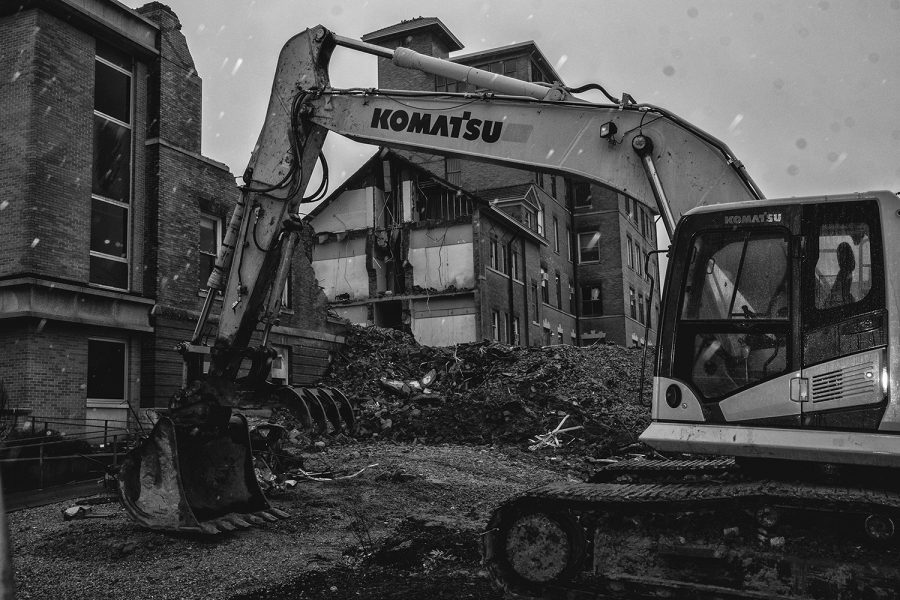Last remaining section of Seashore Hall receives approval for razing
The same year Seashore Hall turns 120, the Board of Regents have approved a request by the University of Iowa to raze the building and replace it with green space for the downtown district.
Progress of the Seashore Hall demolition is seen on Saturday, Feb. 25, 2018. Seashore Hall, which was originally the home of the University hospital, is being torn down to make room for a new building to house the school of Psychological and Brain Sciences.
September 19, 2019
The state Board of Regents on Sept. 19 approved a University of Iowa request to raze Seashore Hall, or what remains of the building after two previous razings demolished its southwest and southeast wings.
According to regents documents, the demolishment of Seashore Hall — in addition to the UI Communications Center — aligns with the university’s master plan and will involve abatement of asbestos-containing materials, removal of underground utilities, and restoration of green space to the project sites.
“[Seashore Hall] hasn’t supported its programs for some time,” UI Campus Planning Director Joe Bilotta said. “Renovations that have happened over time tried to support the academic programs in it, but it really just couldn’t keep up with the change in technology.”
The building’s razing would eliminate $27.8 million in deferred maintenance, the same documents said, which is similar to the estimated price of its replacement. As for demolishment, a Treasurer’s Temporary Investment income of $2,775,000 will cover the costs, according to regent documents.
“Through a lot of analytics and study over the years, it was determined that we shouldn’t be investing too much in the facility, and a replacement facility was going to be the best investment for the state,” Bilotta said.
Celebrating 120 years, Seashore was originally built in 1899 as the UI’s first hospital. The southwest wing was razed because of severe structural deficiencies in 2000, and the regents approved the razing of a southeast section in 2016, according to their documents.
RELATED: Regents committee to recommend new psych building, razing part of Seashore
Bilotta said the reasoning for razing the building in parts and not as a whole was so that programs in it did not lose learning space. With buildings as large as Seashore, he said, demolishment occurs in phases to avoid displacement of entire programs.
The third and final part of the building that requires razing is approximately 128,000 square feet and inadequate for its current teaching and research missions, said regent documents.
In 2016, the regents approved the construction of a new Psychological and Brain Sciences facility, which is projected to open January 2020. Bilotta said some programs may move into that building this winter, but the move is more likely in the spring. The sociology program will be housed on the top floor of North Hall, and construction on this will probably begin next month.
“If you’ve been to campus, you can see Seashore Hall’s sort of on life support,” UI Campus Planning and Development Business Manager David Kieft said.
The building will be replaced with green space for gathering, which will help connect downtown Iowa City to the North Side Market area.
The envisioned space is best described as “park-like,” Bilotta said, and officials hope it will improve the pedestrian corridor to Linn Street. The land on which Seashore stands will evolve into a collegian, mini quadrangle, which sketches for should be ready within the week, he said.
RELATED: Board of Regents discusses razing two houses across from UI campus
However, there is also potential that at least a part of the site could be used for a neurological science facility, Bilotta said. But that depends on the program growing at the UI, and officials don’t certainly expect that anytime soon.
Despite approval from regents to raze it, Seashore probably has at least another year of life before demolishment, Bilotta said. Sociology programs are primarily still in the building and will have to wait probably six to nine months before the new facilities are ready.
“That building really just outlived its usefulness to the institution,” Bilotta said about Seashore. “It’s an old building, but it’s tired. It just wasn’t working. Our programs were not in a space that was needed to be successful.”





